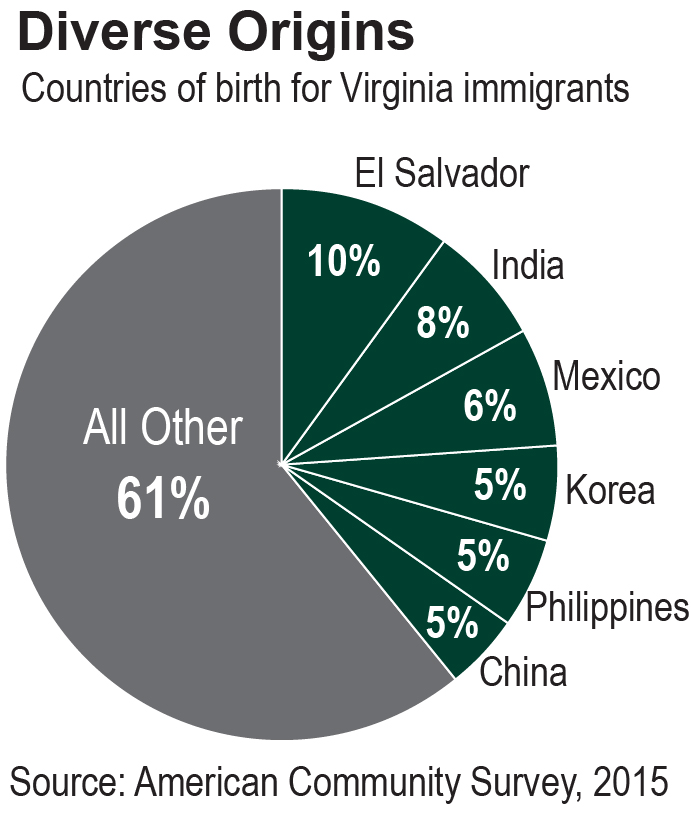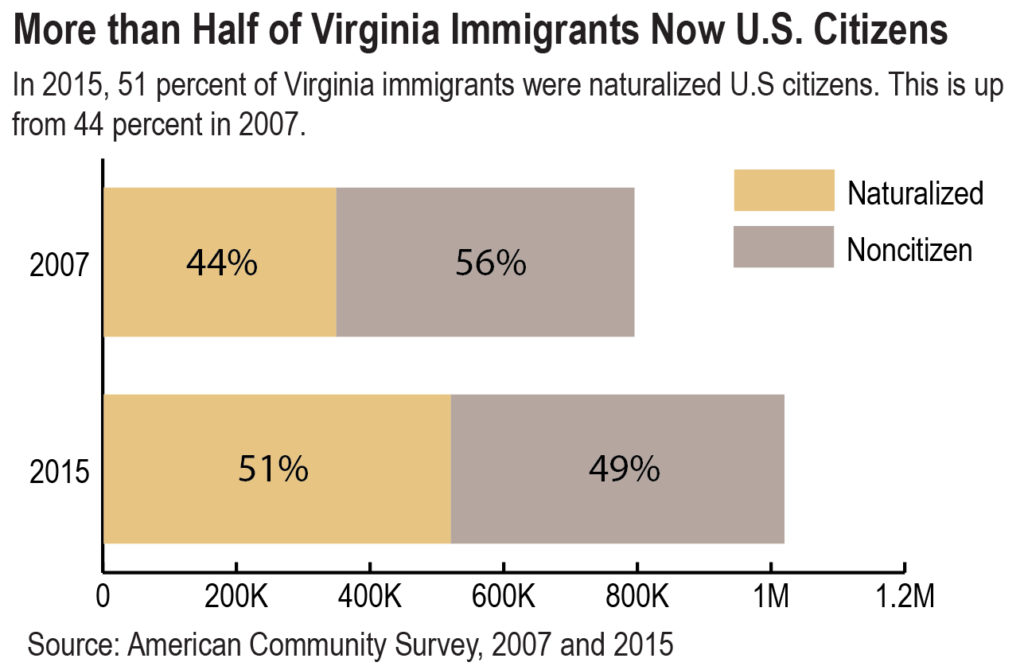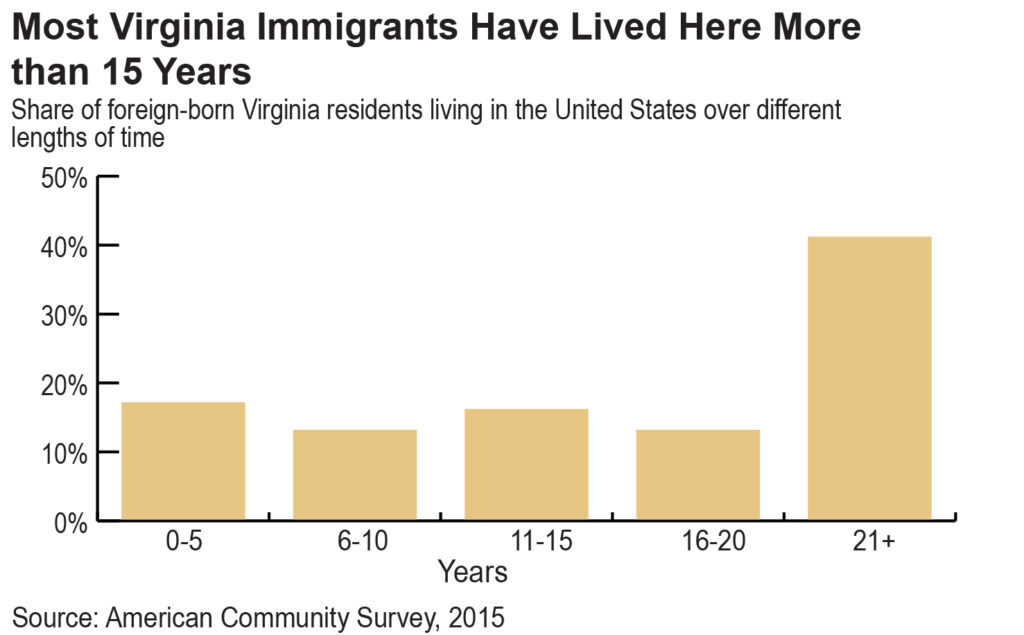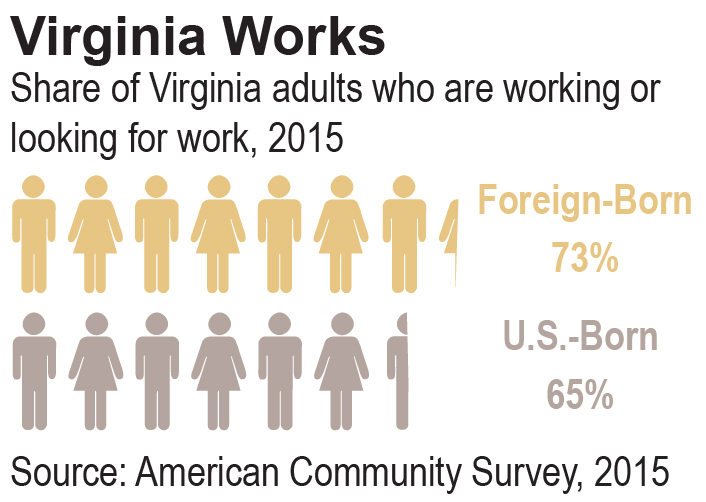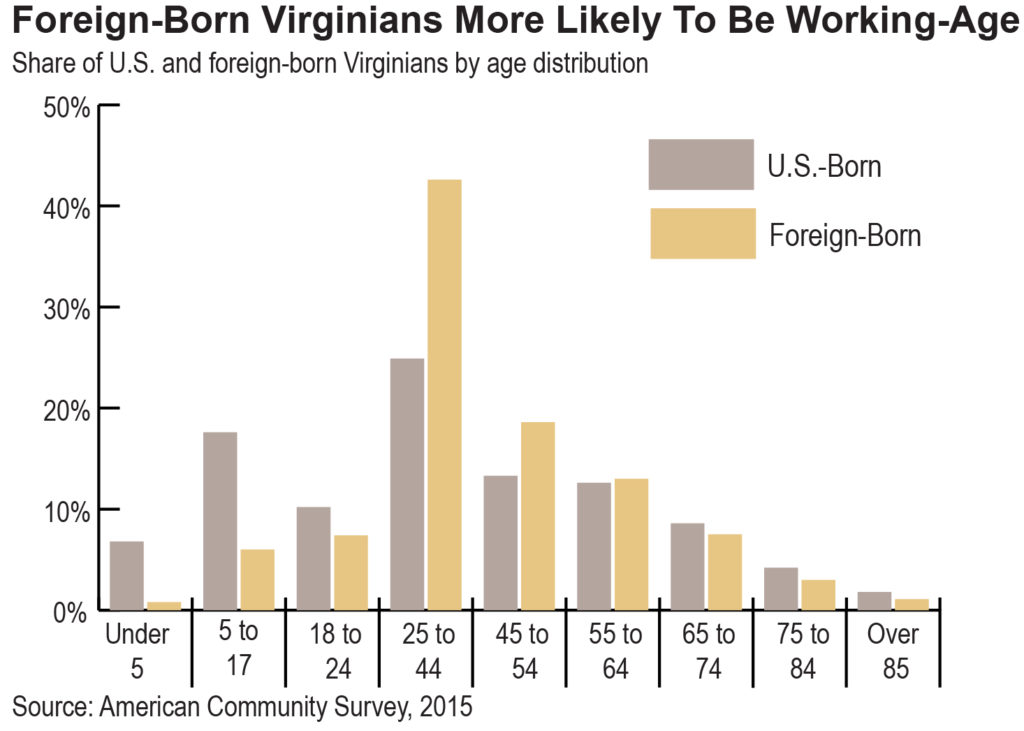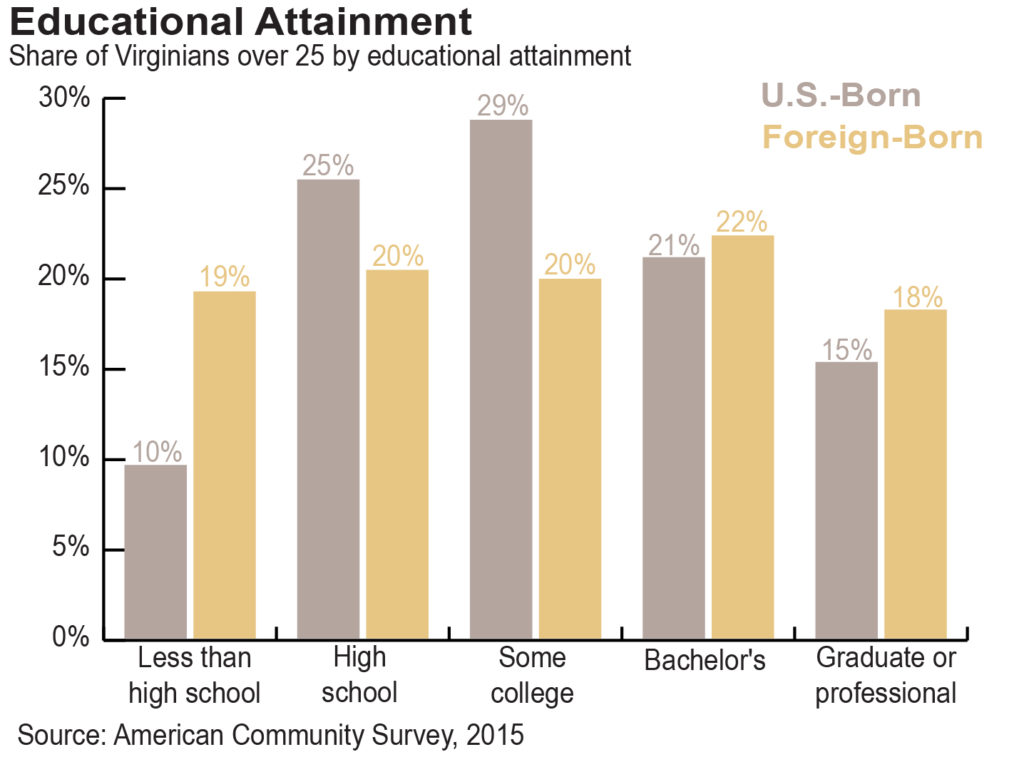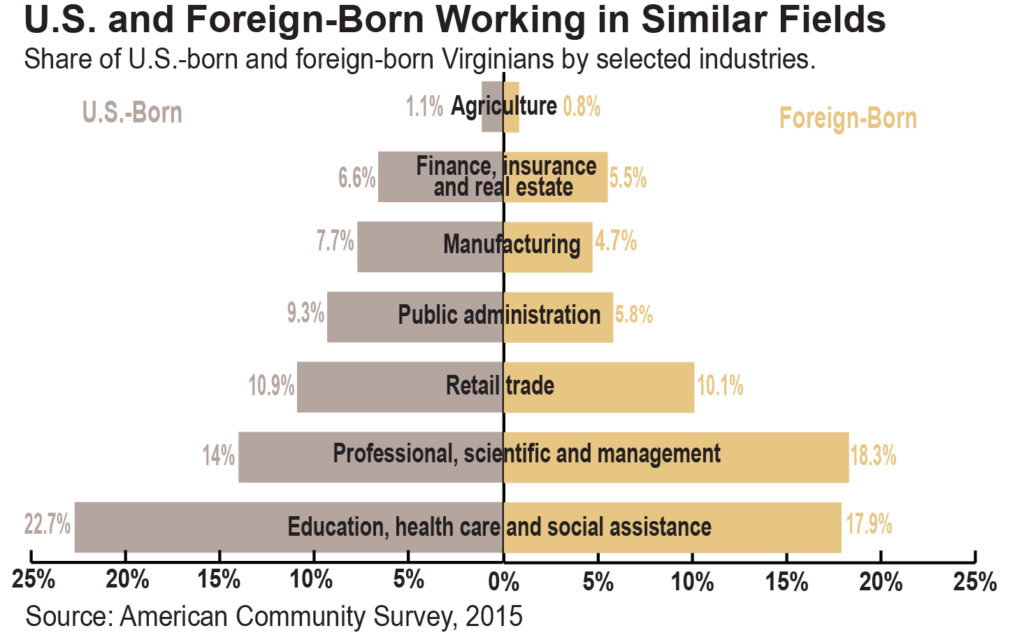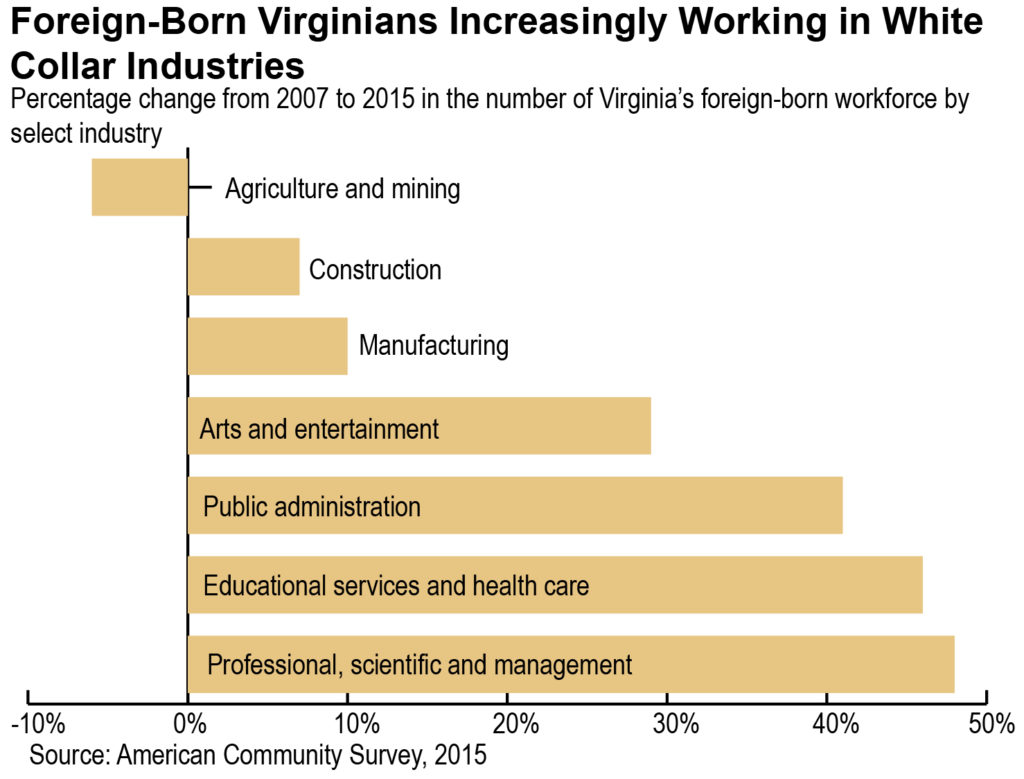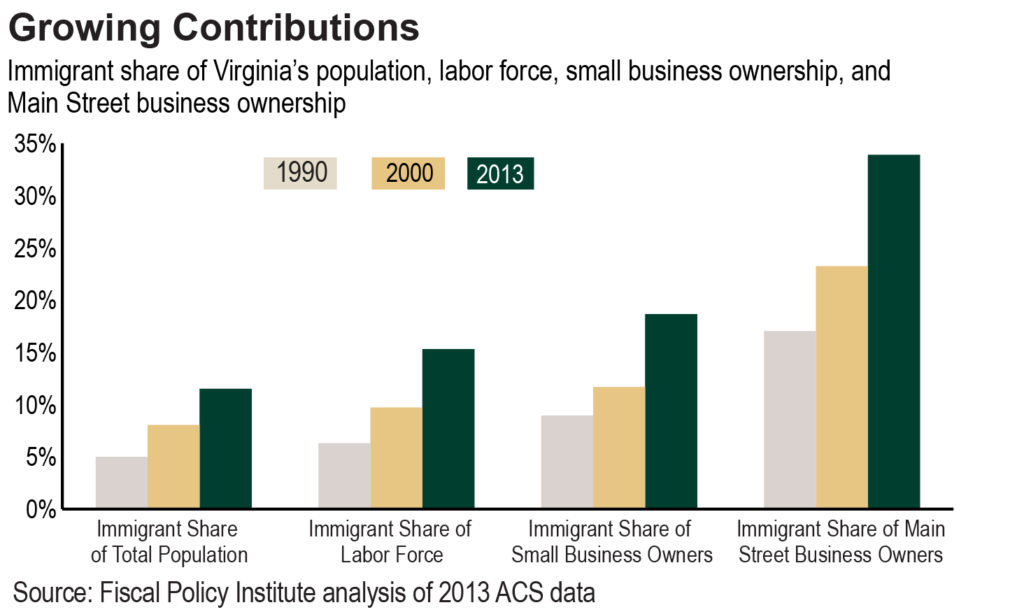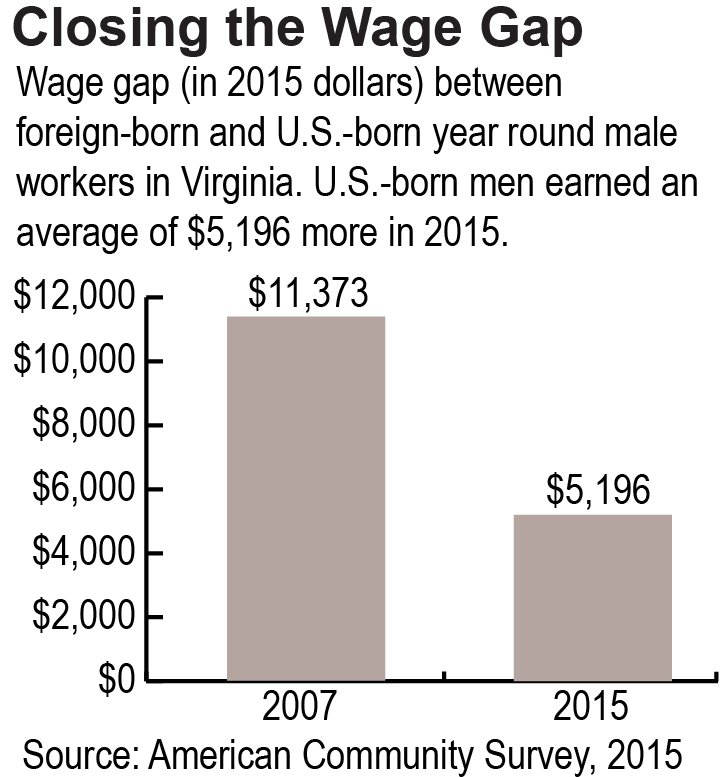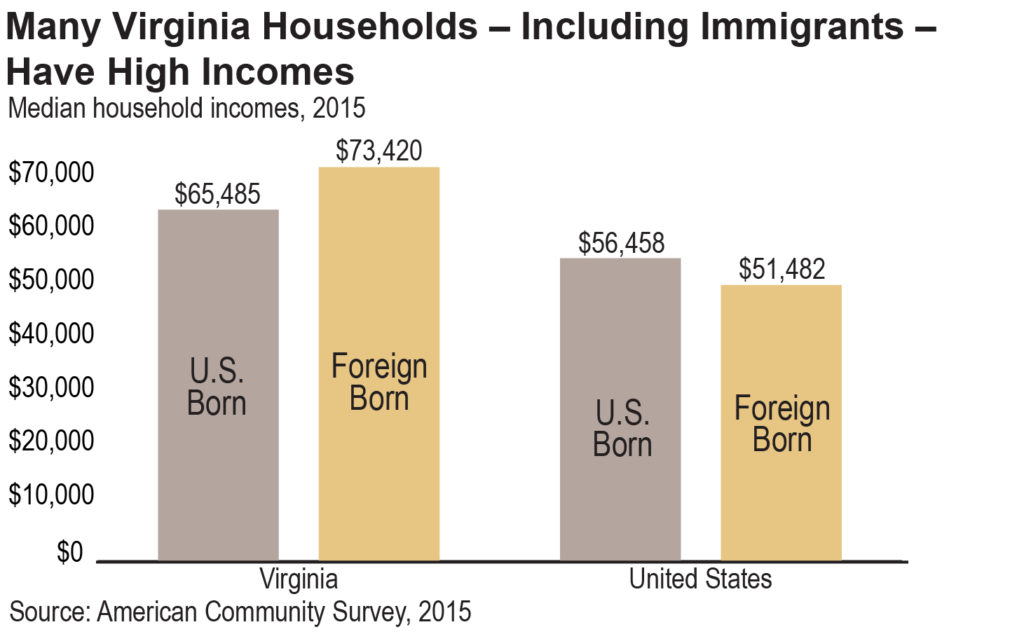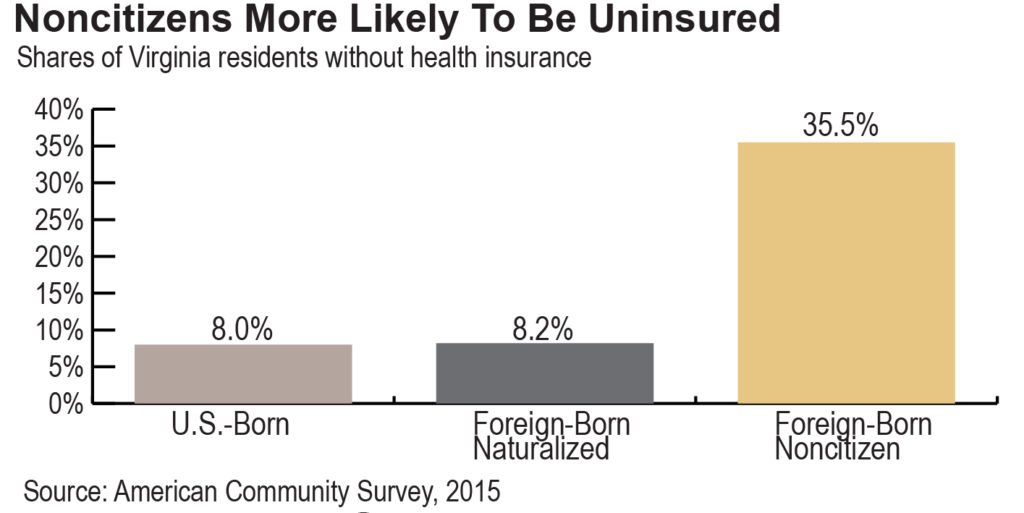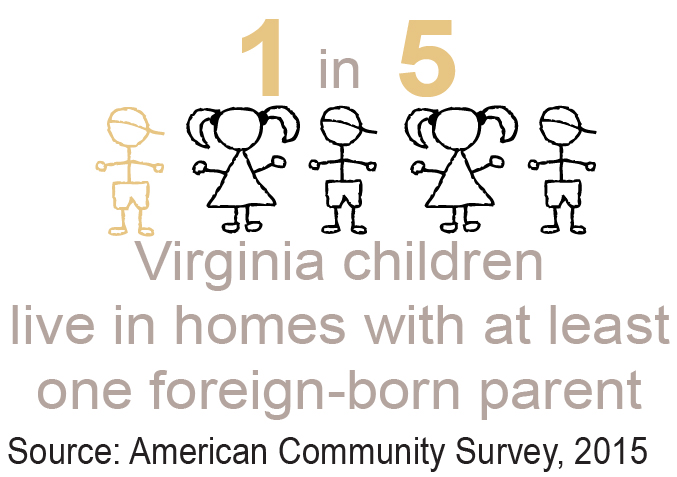April 19, 2017
Virginia Immigrants in the Economy
Pillars of Our Prosperity
Virginia’s immigrants are diverse, growing in number, and are major contributors to our state’s economy. Immigrants in Virginia today are more educated, higher earning, naturalizing at faster rates and living in more communities throughout the state than in recent generations.
Part of the Community
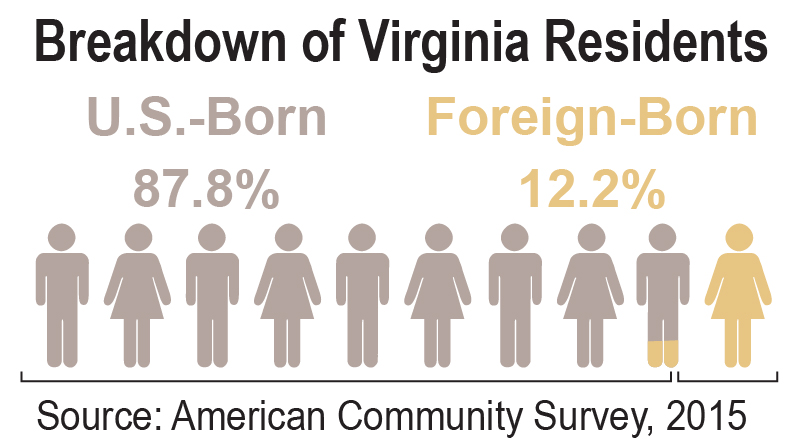
Today there are more than one million immigrants in Virginia. From 2007 to 2015, the number of immigrants in Virginia has grown four times as fast as the U.S.-born population. Immigrant Virginians now make up 12.2 percent of the state’s overall population, slightly below the national average of 13.5 percent.
Virginia’s immigrants come from all over the world. In the national debates, immigration from Mexico tends to dominate the image of immigrants. Nationally, Mexican immigrants are indeed the biggest group, making up about 27 percent of all immigrants. But in Virginia, no single group dominates. Mexican immigrants make up just 6 percent of all immigrants in Virginia, third after people born in El Salvador (10 percent) and India (8 percent). Looking at continent of birth, rather than country of birth, there is a similar diversity. Forty-two percent of Virginia’s immigrant population was born in Asia, the largest group from any continent.
The majority of immigrants that come to the state choose to live in Northern Virginia. Over two-thirds of the state’s immigrant population lives in Northern Virginia, making up around 27 percent of the total population in that region.
Most of the immigrant growth in the commonwealth over the past decade has been driven by an increase in naturalized citizens – foreign-born residents who have lived in the United States for at least five years, applied for naturalization, and passed a citizenship test in addition to other requirements. The naturalized immigrant population in the state has grown nearly 50 percent in Virginia since 2007, almost twice as fast as the national rate. By comparison, the state’s population of noncitizen immigrants has only grown by 12 percent since 2007.
Contrary to the impression of some, most immigrants in Virginia are not newcomers to the U.S. Most of Virginia’s immigrants have been in the U.S. for a long time. Around 83 percent of Virginia immigrants have now been in the United States for more than 5 years. In fact, nearly 70 percent of Virginia’s immigrants have been here for more than 10 years – up 12 percentage points since before the recession.
Core Contributors
There are many economic advantages of a strong immigrant population.
Overall, Virginia’s state workforce is aging. For example, an estimated 25 percent of our state government workforce will be eligible to retire over the next five years. It will be vital for the state to look to replace these baby-boomers with a new generation of educated and productive workers. Legislators often bemoan the fact that workforce participation within the state has declined recently, leaving the state vulnerable to a shrinking tax base. What’s less commonly noted is the role Virginia immigrants play in supporting the labor force overall. Immigrants participate in Virginia’s workforce at a much higher rate than U.S.-born residents – 73 percent compared to 65 percent – and at a rate 7 percentage points higher than the national participation for foreign-born residents.
Virginia and Maryland are fortunate to have the highest immigrant workforce participation rates nationally, excluding D.C., and below average unemployment rates. Most immigrants in Virginia are within the prime working ages of 25-54, compared to a much smaller share who are children or seniors. There are strong benefits to the state’s economy from having such an age distribution. Children and seniors often require more public resources in the form of education and health care. The fact that a larger share of Virginia’s immigrant population are of prime working age, coupled with the fact that workers within the 25 to 54 age span have the highest workforce participation rates, means that they are making an outsized contribution to the state’s economy.
In terms of education, Virginia immigrants are more likely to hold a bachelor’s or advanced degree compared to U.S.-born residents. Of the top 10 states with the largest immigrant populations, Virginia leads in the share of foreign-born residents with a bachelor’s degree or higher.
Immigrants in Virginia are becoming increasingly fluent in English (meaning they speak it very well or only speak English). They are significantly more likely to speak English “very well” compared to all U.S. immigrants and rank fifth for most fluent out of all states. Over 60 percent of immigrants five and older in Virginia speak English “very well.”
In sum, Virginia immigrants are relatively young, well educated, fluent in English, and more likely to participate in the workforce. This powerful combination reflects the substantial capacity for immigrants to contribute to the state’s economy.
Virginia’s Immigrants Live and Work Across a Variety of Settings
Immigrant Virginians work in a wide range of industries throughout the state. While participation rates of immigrants and U.S.-born residents are mostly similar across several industries including agriculture and retail trade, there are some areas of more pronounced difference. A greater share of U.S.-born workers are in manufacturing; finance; education, health services, and social assistance; and public administration. Immigrant workers in Virginia are more likely to work in professional, scientific, and management jobs.
Compared to the average employment of all foreign-born workers in the United States, Virginia’s immigrant workers are much more likely than their immigrant peers nationally to be employed in generally high-skill, high-wage sectors.
Indeed, Virginia is somewhat unique out of all states in that its immigrant population is shifting away from working in mostly “blue-collar” industries that demand more physical labor and are moving to majority “white collar” fields. Behind only D.C., the state’s immigrant population has the highest rate of employment in the professional, scientific, management, and administrative service industry. At the same time, Virginia has the fourth lowest rate of employment among immigrants in manufacturing and the fifth lowest in wholesale trade out of all states and D.C. And looking at occupations, instead of industries, the same story is true. Only 22 percent of the state’s immigrant population works in blue-collar jobs.
Like all other states, Virginia’s immigrant workers are much less likely to work in the public sector than U.S.-born residents. Almost 80 percent of Virginia’s immigrant workers are in the private sector compared to only 74 percent for U.S.-born workers. Still, immigrants living in Virginia are more likely than in the U.S. as a whole to work in the public sector, reflecting their high educational levels and the large role that the federal government plays in Virginia’s economy. Only Maryland and D.C. have a higher rate of public sector employment for their immigrant populations.
Business Owners and Catalysts for Economic Growth
Virginia immigrants are entrepreneurial and much more likely to create, own and operate an independent business than U.S.-born residents. Nearly 11 percent of Virginia’s immigrant workers were self-employed in 2015 compared to only 7 percent of the state’s U.S.-born workers. Around 4 percent of Virginia’s immigrant workers are self-employed owners of incorporated businesses, compared to nearly 3 percent of U.S.-born workers.
Immigrants in Virginia have been the driving force for new business creation. Since 2007, the number of immigrant owners of incorporated businesses in Virginia has increased by 20 percent, while the number of U.S.-born business owners has decreased 8 percent.
One particularly important area that Virginia immigrants contribute to is in Main Street businesses – the brick and mortar establishments that we all go to on a regular basis like grocery stores, restaurants, and clothing stores. Even though Virginia immigrants only make up around 12 percent of the population, they constitute around 34 percent of all Main Street business owners, a rate that is still growing and is 5 percent above the national average.
Main Street businesses can have an outsized effect on local economies. A new grocery store, restaurant, or shop can provide essential community services, save residents time from traveling further for goods, and act as a catalyst to draw in more economic activity in the area. Across the state, three-quarters of grocery stores, and two-thirds of gas stations and dry cleaning/laundry services are immigrant-owned.
Immigrant Men Are Closing the Earnings Gap
Virginia immigrants have somewhat lower wages than their U.S.-born peers, despite having somewhat higher levels of educational attainment. Since before the recession, immigrant men have seen wage gains. The gap between them and their U.S.-born peers in Virginia has narrowed by almost half. Immigrant and U.S.-born working women have also seen wage gains. However, the wage gap has grown for immigrant Virginia women – who now make nearly $3,000 less than their U.S.-born counterparts.
Immigrant men and women in Virginia both have higher wages than immigrants nationally. Both immigrant men and women in Virginia have the second highest median earnings in the South Atlantic region after Maryland. Immigrant Virginia men and women on average earn $10,400 and $5,700 more, respectively, than immigrant counterparts in other states. While U.S.-born Virginians also make more than their U.S.-born counterparts in other states, the difference is less than half what it is for immigrant state residents.
High Household Incomes for Both Immigrants and Others in Virginia
Incomes
Virginia bucks the trend nationally when it comes to what are usually lower incomes for immigrant-headed households. High levels of employment among foreign-born Virginians mean that many households headed by immigrants are doing well despite somewhat lower wages than their U.S.-born peers. Whether foreign-born or U.S.-born, the typical household income in Virginia is higher than in the U.S. as a whole.
And looking within Virginia, immigrant households are doing well. While both immigrant men and women lag in personal earnings, because they have higher participation rates than U.S.-born residents they tend to have higher overall household earnings. Additionally, more immigrant Virginians are within the prime working-age, meaning households are more likely to have two members in the workforce. In fact, immigrant households within Virginia tend to have an average of 1.71 workers per household, compared to only 1.25 for U.S.-born households. Immigrant households are also generally slightly larger than U.S.-born households, helping boost the number of working adults per household and therefore household income.
This helps push up incomes for Virginia households that are headed by immigrants. These households have a median income of $73,420, compared to $65,485 for U.S.-born households – a spread of nearly $8,000. In addition, this spread has been widening since before the recession. Nationally, U.S.-born households typically earn an average of nearly $5,000 more than immigrant households.
Immigrants & wages for U.S.-born workers
A common misconception is that immigrants do not add new jobs, or that they take jobs that U.S.-born populations would work otherwise. In fact, immigrants actually create jobs: directly, when they start new businesses and hire employees; and indirectly, when they expand the economy as consumers and investors.
Economists are in stronger agreement about the role immigrants play in economic growth than is commonly recognized. There is also general agreement among economists that immigrants positively impact the economy, and do not reduce the wages of native-born workers over the long term. Adding low-skilled workers has tended to push U.S.-born workers up in the labor market, not out of it. And high-skilled immigration has helped make the country competitive in technology and many other areas.
There is disagreement, however, over the impact that immigration has on workers with less than a high school degree. Studies have fluctuated between slightly negative to positive for net impacts of immigration on U.S.-born workers with less than a high school degree. Still, there is agreement that there have been negative impacts on wages and employment for black men with less than a high school degree.
From a policy perspective, it would make sense to look to ways to improve working conditions and outcomes for black men with less formal education while also harnessing the overall economic gains of immigration. The alternative – restricting immigration in the hopes of protecting the wages of men with less formal education – is not a winning formula for economic growth.
Despite Success, Challenges Remain for Immigrants in Virginia
Access to health coverage remains low
Naturalized immigrant citizens within the commonwealth have comparable health insurance coverage to the U.S.-born population. However, Virginia has made little progress on increasing access to health care for immigrant noncitizen residents within the state. More than 35 percent of noncitizen residents lack access to health insurance, the same as the national rate. While the national uninsured rate for noncitizens has dropped nearly 13 percentage points since 2009, Virginia’s rate has dropped just over 3 percentage points. This means that Virginia is lagging behind compared to other states in reducing the share of uninsured noncitizens.
When a specific segment of a population lacks health insurance, they are systematically disadvantaged – missing out on opportunities to seek preventive treatment and forced to live with conditions that may impact their work productivity or ability to maintain a job. Virginia’s failure to expand Medicaid access within the state as a part of the Affordable Care Act, as well as the extra barriers Virginia has erected for lawfully present immigrants seeking public health insurance, has likely contributed to the state’s slower reduction in the number of uninsured residents compared to other states.
Poverty still higher for all groups after the recession
Since before the recession, poverty rates at the state and national level have increased for U.S.- and foreign-born residents alike. However, Virginia’s poverty rate for both U.S.- and foreign-born residents remains far below the national averages. As of 2015, both U.S.- and foreign-born Virginians had poverty rates between 11 and 12 percent.
Virginia has moved from 7th to 4th as the state with the lowest share of immigrant residents living below the poverty line since before the recession. At the same time that Virginia is faring better than most states, there were over 115,000 immigrant state residents living below the poverty line in 2015 compared to only 79,000 in 2007. While Virginia is doing better than most, there is still progress that must be made to reverse the trend of many immigrants living in poverty.
Homeownership in decline
Housing remains by far the largest expenditure for households in the United States each year. In 2015, housing cost an average of 19 percent of household income for homeowners, and renting cost an average of 30 percent of household income. In Virginia, about 31 percent of immigrant and 22 percent of U.S.-born homeowners pay more than 30 percent of their income towards housing costs – a rate considered by the Department of Housing and Urban Development to make a family “housing cost burdened,” leading to “difficulty affording necessities such as food, clothing, transportation and medical care.” For renters in Virginia the share of households paying more than 30 percent of their income for housing is even higher, 46 percent for U.S.-born residents and 48 percent for foreign-born.
The Great Recession raised many concerns about the dangers of a housing bubble and predatory lending. Despite these very real concerns, however, homeownership is one of the most important contributors to a growing economy and a goal for most families in the U.S. Immigrants are often cited as playing a critical role in driving housing demand, maintaining property values and stabilizing neighborhoods that are in decline. Yet for both U.S.-born and immigrant Virginians, the dream of homeownership has been slipping away since the start of the recession. Virginia still has higher homeownership rates than the national average, but ownership for immigrant residents has dropped substantially from 63 percent in 2007 to 56 percent in 2015.
In addition to homeownership falling since the recession, median housing prices in Virginia have not recovered and are still down 9 percent from their high in 2007. Meanwhile, rent prices have been increasing across the state. Because immigrants are more likely to rent than U.S.-born residents, their budgets are more likely to be impacted when rent prices increase.
Given that the majority of immigrants live in the Northern Virginia region, and the fact that the average home price in this area is $557,325 – one of the more expensive of any region in the country – homeownership remains out of reach for many Virginia immigrants. Reducing barriers to new construction of high-density, affordable and/or mixed-income housing could be one way to lower housing costs in this region. But as of now, finding a home in this region in the lower price brackets – under $500,000 – is particularly competitive, even without challenges that many immigrants face such as language barriers and being newer to the market than U.S.-born residents.
Since the recession, the largest drop in homeownership in Virginia has been for noncitizen immigrant households. This group now has only a slightly higher homeownership rate than the national average of 33 percent. Virginia’s naturalized immigrant households on the other hand still retain a homeownership rate well above the national average.
Naturalized Virginia immigrant households have homeownership rates higher even than U.S.-born residents. These immigrants tend to have lived in the United States longer and are more likely to speak English very well than noncitizen immigrants. These skills provide naturalized immigrants with distinct advantages to accessing the housing market over noncitizen immigrants, and may partially explain some of the differences in homeownership.
The ‘brain waste’ effect
Despite high levels of educational attainment, immigrants in Virginia are less likely to work in jobs that require their level of credentials than U.S.-born residents – an effect commonly referred to as “brain waste.” Brain waste occurs when individuals have at least a college level of education and are either working in a field that does not require this credential or are unemployed. In Virginia, 21 percent of college-educated immigrants 25 and older are working in low-skill jobs or are unemployed. This is well above the average for U.S.-born Virginians. Immigrants who earn their degrees abroad particularly struggle with brain waste. Creating clearer paths for transferring credentials earned abroad could lead to the state better taking advantage of its highly educated immigrant workforce.
The language barrier
Virginia’s share of immigrants who speak English “very well” has increased since the start of the recession. While the majority of naturalized immigrants speak English very well, just under half of noncitizen immigrants do. Since the majority of new immigrants who are not yet naturalized are also young working-age adults, they may never receive English-language services upon arrival to the United States. Lack of access to these services poses substantial barriers for this population in accessing the job market and post-secondary education.
Unique Challenges Facing Unauthorized and Mixed-Status Commonwealth Families
The majority of Virginia’s immigrant population are legally present in the United States. Since the start of the recession, the number of unauthorized immigrants in the U.S. has decreased by over one million. Much of this decline has been from Mexican unauthorized immigrants leaving, a trend that likely had less impact in Virginia than in border states. As of 2014, Virginia had an estimated 272,000 to 300,000 unauthorized immigrant residents, representing a diverse group from all over the world, according to estimates by the Pew Research Center and the Migration Policy Institute. One of the largest countries of origin is El Salvador (16 percent), a country that experienced a civil war lasting more than a decade.
As with immigrants overall, in Virginia unauthorized immigrants have lived in the U.S. for a long time. An estimated three out of four unauthorized immigrants in Virginia have been in the United States for over five years. The median years of residence for unauthorized residents in the U.S. as of 2014 was nearly 14 years.
Many unauthorized immigrants have had families or married since they arrived. More than a quarter of unauthorized immigrant Virginians live with a child under 18 who is a U.S. citizen. This number does not account for unauthorized immigrants who have children who are citizens not living with them. Additionally, around 15 percent of unauthorized immigrant Virginians are married to a U.S. citizen or legal permanent resident.
Unauthorized immigrants have very high labor force participation rates – higher even than immigrants overall. Around 75 percent of unauthorized Virginians participate in the labor force, well above the 65 percent rate for the state’s U.S.-born population. Working aged unauthorized immigrants over 16 represented only 3.75 percent of Virginia’s overall population in 2014, yet constituted 6 percent of the workforce.
Each year, unauthorized immigrants in Virginia pay more than $250 million in state and local taxes. And were unauthorized immigrants offered a path to citizenship, the state could generate an estimated $100 million in additional state and local taxes on an annual basis through increased tax compliance.
When it comes to post-secondary education, Virginia’s unauthorized immigrants are not far behind the U.S.-born population. Nearly 40 percent of unauthorized immigrants have attained at least some college or an associate’s degree. And of this group, a majority have earned a bachelor’s, graduate, or professional degree.
Some of Virginia’s 272,000 to 300,000 unauthorized immigrants have been offered temporary protection from deportation. Nationally, around 10 percent of unauthorized immigrants have successfully applied for the Deferred Action for Childhood Arrivals program, including over 11,000 young Virginians. This program provides temporary protection from deportation to unauthorized immigrants who came to the country as children, have little to no criminal records and are seeking post-secondary education or have completed a high school equivalent of education. Not counted in those estimates of unauthorized immigrants are Virginians who have been granted Temporary Protected Status due to threats from returning to their home countries. This is particularly important for Virginia’s largest immigrant group from El Salvador, many of whom fled during the country’s civil war.
While unauthorized immigrants are major contributors to the state’s economy, they continue to face numerous challenges. Nearly one out of five live below the poverty line and around 58 percent lack health insurance – these are both well above the U.S.-born rates.
In addition to the slew of challenges posed by not having health insurance and being more likely to be living below the poverty line, hate crimes towards immigrant groups have been on the rise in the United States over the last few years. Some hatewatch groups have cited charged political rhetoric and unsubstantiated statements about the threats posed by immigrants as contributing factors to increases in intimidation and discrimination. Experiences interacting with immigrants do not seem to be the cause of hate crimes – when more people interact with immigrants as neighbors, co-workers, and community members, they tend to have more positive feelings for the group. States that have higher concentrations of immigrants have been shown to be correlated with fewer hate groups per capita.
Children of immigrants are particularly affected by charged discriminatory rhetoric. Many of these children live in fear of their parents being detained, arrested, or deported. An estimated 90,000 immigrant parents of U.S.-citizen children were deported each year between 2010 and 2012. Deportation of parents has been shown to lead to higher rates of anxiety, depression, and post-traumatic stress disorder among the remaining family members. Additionally, median income for these households on average drops below the poverty line from $36,000 to $15,400 when a family member is deported and health conditions for the remaining family members also decline. With so many additional stressors, children who come from households where parents are under threat of deportation are more likely to struggle in school, have lower literacy rates in adulthood, and have difficulty finding employment.
In addition, many unauthorized immigrants have lived here for more than a decade, married citizens, had children, and pay taxes. Despite their contributions, however, unauthorized immigrants are not offered the same level of social services offered to other state residents. Lack of access to health care and threats of deportation and discrimination all make unauthorized immigrants and their families less able to contribute to the communities in which they live. And when unauthorized immigrants are treated like non-members of their communities, they are much more likely to be impacted by mental illness and economic hardship.
Conclusion
Virginian immigrants are key contributors to the state’s growth and prosperity. A majority of these immigrants are U.S. citizens and have lived in the country for more than 10 years. Yet despite how well Virginia’s immigrants have integrated, there are still many challenges that face immigrant communities. Health insurance access, discrimination, language barriers, “brain waste,” and housing costs all pose unique challenges for immigrants – particularly noncitizen immigrants. Fully tapping into the potential of this highly educated and largely working-age population will mean moving at the state and local level to break down barriers and better integrate immigrants into Virginia’s communities and economy.
